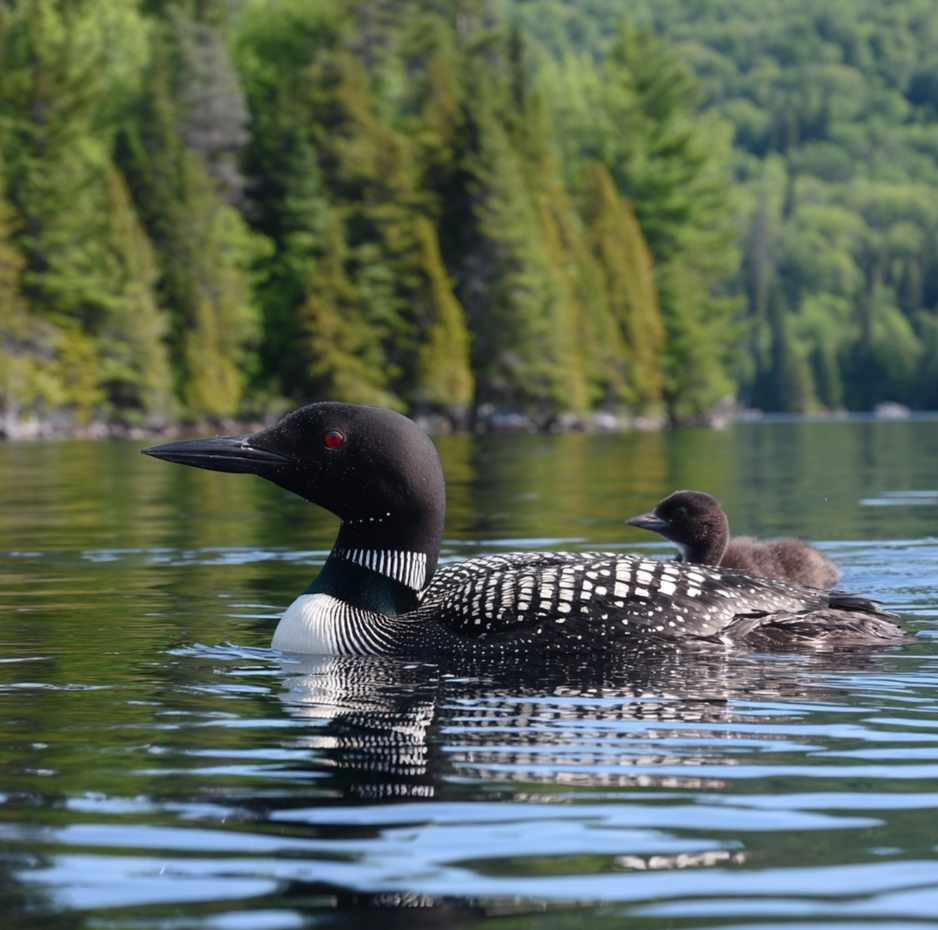
Nature's Quality Assurance Programme
Across Muskoka's pristine lakes this July, an ancient conversation unfolds each dawn and dusk. The call of the loon is different. Wherever, whenever and however you happen to be reading this — on a crowded subway or home in bed, in a dentist's office or on a beach, scrolling through your phone at work or waiting for a friend at a bar — if I asked you to remember the call of the loon, you could. But what if I told you these haunting calls aren't just beautiful—they're actually sophisticated reports on your lake's environmental health?For discerning waterfront property owners and prospective buyers, understanding loon behaviour offers invaluable insights into ecosystem quality that traditional water testing might miss. As biological indicators, blood and feather samples from common loons reveal the presence and levels of environmental pollutants. By monitoring loons' nesting success, researchers gain valuable information about stressors to lake habitats.The Loon's Vocal Vocabulary: Four Calls That Matter
The Wail: Nature's Location Service
The wail is the haunting call that loons give back and forth to figure out each other's location. During July's peak breeding season, frequent wailing between paired loons indicates a healthy, established territory. The wail serves as long distance communication between mating pairs. It's the sound of nature longing. When you hear regular wailing patterns across your lake, it suggests optimal breeding conditions and minimal environmental stress.The Tremolo: The Alarm System
The tremolo is a wavering call given when a loon is alarmed or to announce its presence at a lake. It often uses this call to signal distress or alarm caused by territorial disputes or perceived threats. The tremolo call has varying three levels of intensities that correlate with a loon's level of distress. Increased tremolo activity during July may indicate elevated mercury levels, water quality issues, or increased human disturbance—all factors that affect property desirability.The Yodel: Territorial Claims and Male Health
The yodel is the male loon's territorial claim. Each male has his own signature yodel. If a male moves to a different territory, he will change his yodel. More significantly for waterfront investors, the dominant frequencies in the yodel indicate the body mass and thereby the health of males. Robust, frequent yodelling suggests healthy fish populations and excellent water quality—premium conditions for luxury waterfront properties.The Hoot: Family Communication
Hoots are soft, short calls given to keep in contact with each other. Parents might hoot to a chick, or one mate might hoot to another. Regular hooting during July indicates successful breeding pairs with chicks—a strong indicator of ecosystem stability that supports long-term property values.July: Peak Performance Season
July represents the pinnacle of loon breeding activity in Muskoka. Loons are most vocal from mid-May to mid-June. However, July behaviour reveals the true success of breeding efforts. Loon chicks reach fledgling age. Their primary flight feathers are last to develop, and, although they are the size of adults, the chicks are not able to fly until they are 11 to 12 weeks of age.During the breeding season (April to October), Common Loons can be found in freshwater habitats ranging from Boreal lakes to open wetlands. For nesting, loons look for large lakes with clear water and many bays, points, and islands. The presence of active families during July indicates your lake meets the most stringent natural quality standards.Loons as Environmental Sentinels
Mercury: The Silent Threat
The common loon is a key indicator of mercury deposition in aquatic environments due to its position at the top of the food chain. Mercury is one of the most serious contaminants threatening our Nation's waters because it is a potent neurological poison in fish, wildlife, and humans. It is a global pollutant that ultimately makes its way into every aquatic ecosystem. In Muskoka's increasingly sought-after waterfront market, properties on lakes with healthy loon populations demonstrate measurably lower mercury levels—a critical health consideration for families.Water Clarity and Fish Population Health
Clear water is important for Common Loons as they rely heavily on their eyesight for hunting. While they have particularly good eyesight below the water, murky water impedes their ability to locate prey. Deep lakes with warm surface waters, relatively low biological productivity and low turbidity where their fish prey are easy to see are habitats where breeding loons are more successful in raising young.When loons thrive, it indicates abundant small fish populations—the foundation of a healthy aquatic ecosystem that supports exceptional recreational fishing and maintains long-term ecological balance.Climate Change and Evolving Challenges
Recent research reveals concerning trends even in previously pristine areas. Starting in about the early 2000s, productivity declined on average to roughly half that observed in previous decades, and years with especially high productivity stopped occurring altogether at that time. The numbers of breeding adults observed now is as low, or lower, than those seen during the aftermath of acid rain in the 1980s and 1990s.Reading the Signs: What to Listen For
Healthy Lake Indicators:
- Regular dawn and dusk wailing between established pairs
- Consistent territory yodelling throughout July
- Soft hooting indicating successful chick-rearing
- Minimal tremolo calling suggesting low stress levels
Warning Signs:
- Excessive tremolo activity indicating environmental stress
- Absence of territorial calls during peak season
- Single loons without pair bonding suggesting population decline
- Aggressive territorial disputes indicating resource scarcity
Muskoka's Loon Advantage
Over half of the breeding population in North America is found in Ontario with 97,000 territorial pairs. The Canadian Lakes Loon Survey has been undertaken annually by volunteers coordinated by Bird Studies Canada since 1981. This extensive monitoring provides unprecedented data on Muskoka's water quality trends.Loons have long had a stronghold in Muskoka, with many lakes having at least one nesting pair. The sudden disappearance of a loon pair would be quickly noticed by any locals. This natural early warning system provides waterfront property owners with real-time environmental monitoring that technological solutions cannot match.Investment Implications
Properties on lakes supporting healthy loon populations demonstrate several investment advantages:Environmental Quality Assurance: Loon presence indicates water quality meeting the highest natural standards—crucial for long-term property values and family health.Recreational Excellence: Healthy loon populations correlate with excellent fishing, pristine swimming conditions, and superior recreational opportunities that drive premium pricing.Regulatory Protection: Lakes supporting threatened species often receive enhanced environmental protection, safeguarding long-term development pressures and maintaining exclusivity.Practical Applications for Property Owners
Monitoring Your Investment
Regular observation of loon behaviour provides ongoing assessment of your property's environmental asset value. Document calling patterns, nesting success, and family groups to track trends over time.Enhancing Habitat Value
Boat wakes, waves and high water can be deadly for loon nests. Heavily developed shorelines often have no appropriate nesting locations and come with increased chances of human disturbance. Thoughtful property management that minimises wake impact and preserves natural shoreline features enhances both loon habitat and property values.Looking Forward: Conservation and Value Protection
The relationship between loon health and property values will only strengthen as environmental quality becomes increasingly scarce and valuable.Properties that maintain healthy loon populations demonstrate successful adaptation to environmental challenges—a critical factor in long-term value retention. Waiting until we no longer hear the haunting call of the loon is too late.Nature's Premium Certification
The secret language of loons offers waterfront property owners something no inspection report can provide: real-time, ongoing environmental quality assessment by nature's most sophisticated monitoring system. In July, when these ancient conversations reach their peak intensity, they're telling us everything we need to know about water quality, ecosystem health, and long-term environmental stability.For discerning investors in Muskoka's luxury waterfront market, understanding loon language isn't just about appreciating natural beauty—it's about recognising the most reliable indicator of exceptional environmental quality and long-term value protection.The next time you hear that haunting call across your lake on a misty July morning, listen carefully. They're not just singing—they're certifying your investment in one of the world's most pristine aquatic environments.For expert guidance on Muskoka's premium waterfront properties and environmental quality assessment, contact Jay Richardson and the Richardson Team, your trusted waterfront specialists with deep local knowledge and commitment to matching discerning clients with exceptional properties.


